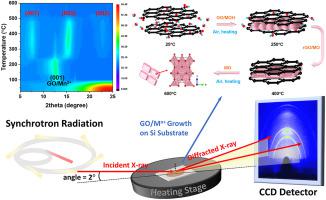Carbon ( IF 10.5 ) Pub Date : 2021-09-02 , DOI: 10.1016/j.carbon.2021.08.073 Zhao Li 1, 2, 3 , Rui Wang 1 , Shuaijin Wu 4 , Zhipeng Xue 1 , Daming Zhu 1 , Jianxin Zou 2, 3 , Xiaolong Li 1

|
The interactions between metal ions and graphene oxide (GO) nanosheets were investigated by in situ two-dimensional grazing incidence X-ray diffraction (GIXRD). We found that metal cations (Mn2+, Co2+, Cu2+, Fe3+) and GO can self-assemble into a hydroxide/GO superlattice by drop-casting a metal chloride and GO solution due to the electrostatic interactions between the positively charged hydroxide and the negatively charged GO nanosheets and the interlayer spacing of the superlattice can be controlled by the cation species. Moreover, based on this superlattice template, graphene-based metal oxide nanosheets can be facilely obtained by subsequent annealing. The growth mechanism and structural evolution of the GO/cation systems can be described in four stages: (1) hydrated cation intercalation of the GO interlayer in an aqueous solution; (2) metal hydroxide growth between the GO layers during annealing, with the formation of a superlattice structure at approximately 250 °C; (3) metal oxide nucleation between the reduced GO (rGO) interlayers with increasing temperature; and (4) complete graphene layer decomposition at a temperature of 600 °C, along with metal oxide nanosheet formation. This work gives a new perspective for understanding the interactions between and growth behaviour of metal cations and GO.
中文翻译:

金属离子与氧化石墨烯层相互作用的原位观察:从金属氢氧化物的生长到金属氧化物的形成
通过原位二维掠入射X射线衍射(GIXRD)研究了金属离子与氧化石墨烯(GO)纳米片之间的相互作用。我们发现金属阳离子 (Mn 2+ , Co 2+ , Cu 2+ , Fe 3+) 和 GO 可以通过滴铸金属氯化物和 GO 溶液自组装成氢氧化物/GO 超晶格,这是由于带正电的氢氧化物和带负电的 GO 纳米片之间的静电相互作用,并且超晶格的层间距可以通过以下方式控制阳离子种类。此外,基于这种超晶格模板,可以通过后续退火轻松获得石墨烯基金属氧化物纳米片。GO/阳离子体系的生长机制和结构演变可以分为四个阶段:(1)水溶液中GO夹层的水合阳离子嵌入;(2) 退火过程中GO层间金属氢氧化物生长,在250℃左右形成超晶格结构;(3) 随着温度的升高,还原的 GO (rGO) 夹层之间的金属氧化物成核;(4) 在 600 °C 的温度下完成石墨烯层分解,同时形成金属氧化物纳米片。这项工作为理解金属阳离子和 GO 之间的相互作用和生长行为提供了新的视角。











































 京公网安备 11010802027423号
京公网安备 11010802027423号